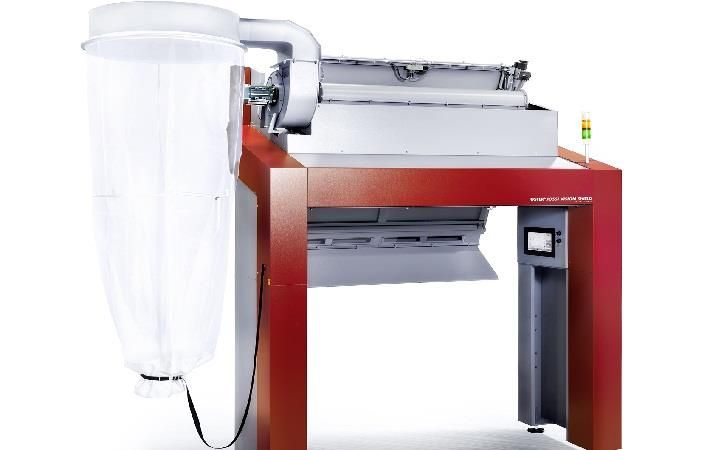
Operating in the preparatory stages before spunlacing, the Uster Jossi Vision Shield deploys the imaging spectroscope technology, identifying contamination in a fraction of a second, and just as quickly removing it from the mass of good fibre material. Detection works across a much greater wavelength than conventional camera systems, so that contamination as small as a single hair and in the lightest colours is pinpointed, even in IR and UV light ranges.
The process of detecting and removing contamination from bleached cotton and man-made fibres inevitably generates some waste. It is important to ensure a minimum of good fibre is lost in this way. Uster Jossi Vision Shield achieves this by continuously measuring the velocity of the fibre tufts. Precision valves then match the timing and duration of each ejection of contamination, so that only the required amount of unwanted material is removed.
For fibre cleaning, tuft size is the key: small contaminant particles can hide inside denser tufts, especially difficult to locate when the material is more compressed. Uster Jossi Vision Shield is ideally positioned to overcome this, directly behind the fine opener in the blowroom. These short channels ensure that the tufts pass the spectroscopes in their most open state. This position also means that the optimal dimensions and compact design of the fibre cleaning system integrate perfectly in the production line.
The quality-boosting credentials of Uster Jossi Vision Shield are underlined still further by its established leading role in the cotton industry, where contamination levels are much higher and more complex. The Uster system’s spectroscopes detect everything – even white polypropylene entangled in tufts. In fact, most cotton spinners hesitate to use the system at its fullest sensitivity, since waste levels might be too high if all contamination was removed.
Nonwovens producers, however, can use all this detection power to achieve the guaranteed levels of both comfort, for contact with human skin, and appearance – as well as the required quality standards for medical uses. For nonwovens, Uster Jossi Vision Shield brings unrivaled detection power and removal efficiency, for top fibre cleaning performance.
Nonwovens globally is a rising textile segment, and India is emerging as a significant player in this, as the third-largest Asian supplier of roll goods. Manufacturing of nonwovens started in India decades ago, initially limited to nonwovens made from staple fibres, using conventional and outmoded methods. Progress came in response to demands for a reduction in basic weights, and spunlace and spunmelt fabrics became important. By 2014 an Indian nonwovens output of 277,000 tons was estimated, and for 2020 and beyond volumes were forecast to reach over 400,000.
“India is a growing market for Uster Jossi fibre cleaning systems, as it develops sensitive nonwovens applications in fast-growing health and hygiene sectors, as well as specialties like security paper printing for currency, where the cotton used is tested thoroughly to avoid contamination,” said Rathnam V Rama, president Uster Technologies Pvt Ltd, India.
The importance of the nonwovens sector for Uster is demonstrated by the company’s presence at the forthcoming Techtextil India 2019 in Mumbai (hall 4, booth f82), a leading international trade fair for technical textiles and nonwovens.
“We are sure that Uster Jossi Vision Shield will attract interest at the exhibition from manufacturers of bleached cotton and other quality-critical nonwovens products for health and hygiene, as they seek to move up the value chain, from low-end and low-priced nonwovens into specialty applications,” said Rama.
Uster Technologies offers high-technology instruments, systems and services for quality control, prediction, certification and optimisation in the textile industry. This includes systems for quality management, laboratory testing and in-line process control for fibres, staple and filament yarns, fabric inspection as well as value-added services.
Fibre2Fashion News Desk (PC)